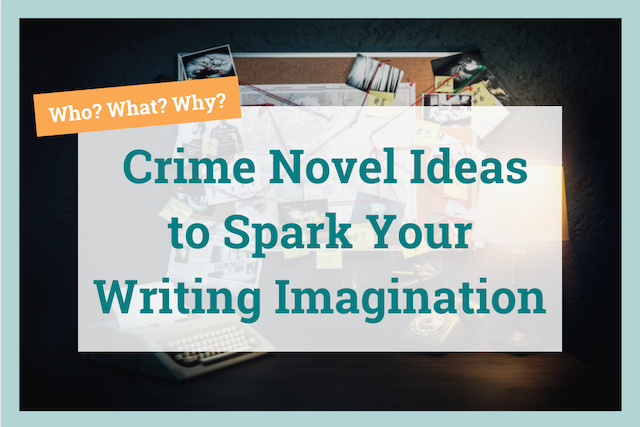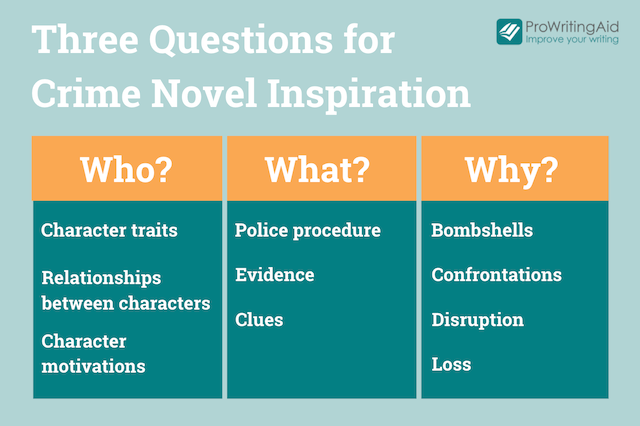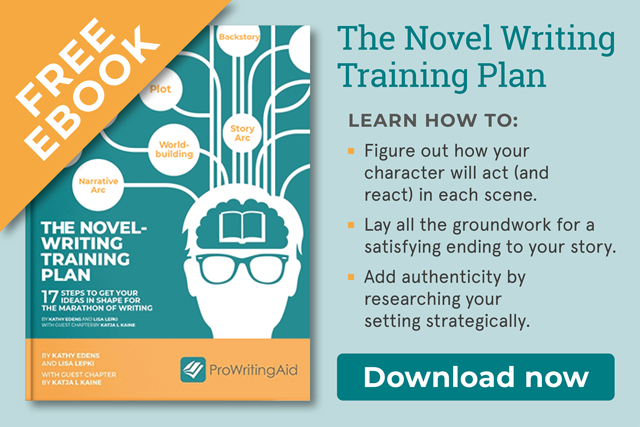
Investigate Ideas for Your Crime Novel
Crime novels are consistently popular with readers. Recent data mining from K-lytics says the Mystery, Thriller, and Suspense category is the second most popular on Amazon.
Sometimes, when a writer turns to a new genre, especially a popular one, it feels like all the stories have been told. You want your novel to stand out and entice readers to grab a copy.
A crime novel is a story about how a detective tracks down a villain who committed a crime—often more than one before the story is over. Ideas for creating a unique crime novel come from asking who, what, and why questions. Who are the characters? How does the detective go about identifying and tracking the perpetrator? And why do things not go according to plan?
The most interesting and challenging questions for your readers are the "why?" questions. If you think about the crime novels that inspire you, you will remember the who of the detective and the how of the cat-and-mouse game, but your reading enjoyment comes from the why possibilities.
"Who?" Ideas
Populate your cast of characters with unique personalities, filled with wants and needs that lead them astray. Use as many or as few of these prompts as you like to find the right angle.
Sleuth
- Your detective is good at sleuthing, but his boss pushes all his buttons.
- Your sleuth despises liars. He misses important clues because a suspect lies.
Villain
- You create a likeable perpetrator. Your reader empathizes and wants them to get away with it.
- The villain has political power over your sleuth.
Victim
- Choose a Myers-Briggs personality type the opposite of yours. Use their traits to explain why they upset the villain.
- The victim is just like you. Why would the villain want to kill you?
Suspect
- A suspect is friends with the villain and thinks your sleuth is picking on the villain. The suspect goes out of their way to protect the villain.
- A suspect gets a crush on the detective and interferes with the investigation.
"What?" Ideas
Ostensibly, your sleuth needs to go by the book. But things can go wrong. Here are six ideas to play with.
Procedure
- It’s your detective’s first case. They forget an important procedure at the crime scene.
- Your detective recently transferred from another county/state. The local procedure guidelines are not the same. She follows the procedure from her old position and gets in trouble.
Evidence
- A crucial piece of evidence gets lost before it reaches the lab. Your detective was sure this would nail the villain. Now he must use his wits.
- Your detective is in a small-town police force. He took a blood spatter analysis once... long ago. He gets it wrong.
Clues
- That clear shoe impression in the soft soil belongs to the gardener/handyman, not the villain.
- The suspect knows exactly what time it was because she looked at the clock. The clock runs fast.

"Why?" Ideas
"Why?" ideas spark your story twists, setting your detective on a new path. Brainstorming them creates intrigue in your crime novel. These ideas will help you flesh out the middle of your story as you create obstacles for your detective protagonist and raise the stakes.
You may have a solid idea for your detective, the crime, and the perpetrator, but you need to create tension by raising questions in your reader’s mind, so they want to continue reading.
"Why?" ideas are the core of maintaining interest in your story over several hundred pages. Here are nine different ways you can do this.
1. Invite Questions
Raise a question in the reader’s mind. It can be as simple as What will happen next? This allows your reader to take ownership and consider various options in light of what they know so far.
Simple questions can lead to further questions. If your hero gets out of the burning building will he have the clue he wanted? If not, how will the sleuth continue without the important clue?
2. Drop a Bombshell
The bombshell refutes everything the detective, and your reader, knows so far.
A suspect declares, “I’m not really her father.” Your sleuth is taken off the case. The detective discovers he is the villain’s next target. The sleuth’s mom dies, and she has to leave, just when she’s getting close to the villain.
After a bombshell, your story takes a new direction. These are great for keeping suspense during the long middle.
3. Use Confrontations
Long before the final confrontation between the sleuth and the villain, your sleuth encounters others who confront his methodology, his belief in the evidence, the logic of his investigation.
Perhaps a seemingly agreeable suspect suddenly turns on your sleuth. You can also give your subplot characters a hard time to raise tension. Confrontations raise the stakes in your story.
4. Create Disruption
Create uncertainty in your sleuth’s investigation by disrupting her plans. Use unexpected or unplanned events or information to derail her plans. She may discover that an ally is intent on destroying her career.
Disruptions don’t have to be big. Just as your detective has the villain trapped in a room, the power goes out. But, each disruption changes the course of the story, forcing your hero to come up with new plans. They can either create additional problems or opportunities for the main character to grow.
5. Introduce Loss
Create a potential or actual loss, such as weapons, information, evidence, or other essential resources that obstruct your character’s path to achieving their goal. It could create mortal danger, uncertainty, or put them in a position of uncomfortable vulnerability. When it’s time for the important item to be there, it’s not. Your character is forced to improvise.
6. Create Doubt with Unexpected Responses
Raise questions about character relationships and motivations. These responses are perfect for creating doubt about suspects. The victim’s boyfriend has no sorrow for her death. Another suspect who had little known relationship with the victim breaks down in tears. The bean-counting CFO is relieved the victim died. The detective’s commanding officer chews him out for his results so far when the detective presents new convincing evidence.
Whatever you’ve led your reader to expect, make the character respond in an opposing way.

7. Create Realism with Delayed Responses
Create sensory realism by showing a character ruminating over a major event. While they are considering how to respond to the event, show them doing something else. These are mood moments that pull your reader into the story.
For example, imagine a crime boss receives devastating news that they are being audited and their bank accounts have been frozen. As they consider their response, they make coffee, performing a detailed ritual of measuring, grinding, pouring boiling water through a filter.
TIP: It’s easy to get caught up in your detective’s thinking mind for large sections of your story. If you really want to engage your reader, make sure you’re using all five senses in your story and considering the spaces around them. ProWritingAid’s Sensory Report will show you the distribution of sensory words in your story so you can check for balance. Learn more and try it out now.
8. Create Intrigue with Hidden Responses
Hidden responses mean you withhold vital information. Use them sparingly, or you’ll frustrate your readers.
A hidden response incident functions effectively as a verbal or non-verbal moment in a scene. A character receives a box, gift-wrapped and tied with a bow. The reader doesn’t know what’s inside. What they learn is the character’s reaction. They snigger or laugh or cringe or scream.
You’ll build suspense. The reader wants to know what’s in the box and why the character responded the way they did. Your reader relies on you to reveal the content of the package later.
9. Use Dramatic Irony
Place your reader in a knowing position. Dramatic irony occurs when the audience knows something that is going on in a situation, but the characters are unaware of what is going on. Because of this understanding, the words and actions of the characters take on a different meaning. This can create intense suspense. Tension develops between what the reader and characters know is happening.
Use this technique intentionally to keep the reader engrossed and engaged.
- Your detective and a suspect sit at an outdoor table at a café. The reader knows the villain is sitting two tables away, intent on killing the suspect. The detective and the suspect don’t know.
- A character drives to a woman’s house with a bouquet of flowers prepared to declare his true love. She is in bed with her lover.
Organize Your Ideas
Ideas in your head, stay in your head. The first step in creating a crime novel is to collect your ideas in a document or several documents. For example, once you know your main characters, write character backgrounds for each one. As you fill in character backgrounds, you’ll have ideas for story moments. Write those down. Then arrange each of those story moments (scenes) in sequence.
You’ll find that writing down your ideas and organizing them will have you well on your way to writing your crime novel. Check out our complete guide to outlining your crime novel to help you get started.
Just for fun, if you want some quirky ideas, try the Crime Novel Plot Generator. You never know what might be the right spark for your imagination.


